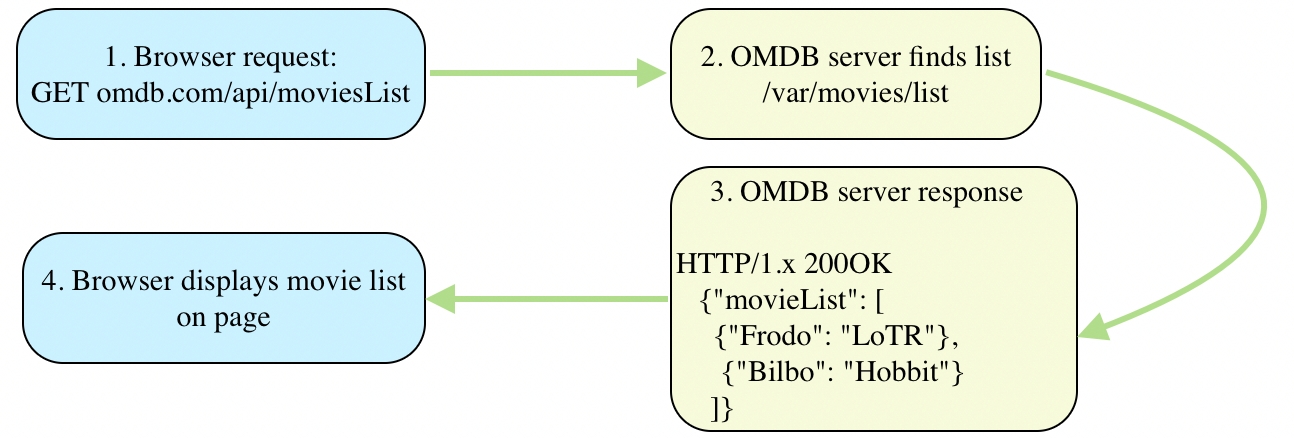APIs with Fetch and Axios
Learning Objectives
After this lesson, you will be able to:
Identify the pieces of a
fetch()callCreate a React component that calls an API
Introducing fetch()
fetch()So... we know what an API is. Now what?
How can we use an API to dynamically manipulate the DOM with the given data? We can use fetch().
In the past, these have been called AJAX requests. As you'll come to learn, fetch() allows us to build single page applications that do not require refreshes.
AJAX, which stands for "Asynchronous Javascript and XML," is the method through which we are able to make HTTP requests. The standard requests we will be making are GET POST PUT PATCH and DELETE.
Type of Request
What's It Do?
GET
Read ('give me movie names from your database')
POST
Create ('here's a new movie for your database')
PATCH
Update ('hey, this movie has a new title'))
PUT
Update ('hey, this movie totally changed')
DELETE
Delete ('that movie is so bad you should just take it out of the database')
The browser packages this together using fetch() and sends it off to a server. The server then listens to your request and provides a response. It looks something like this:

When you browse to your favorite websites, your browser is making a request and the server is providing a response. fetch() allows us to perform the same type of requests over a network. Imagine fetching weather information and rendering it on your website. You can use fetch() to build these applications.
Taking a look at fetch in action
That was a lot! Let's take a look at fetch() in action.
Imagine we want to fetch() the number of astronauts currently aboard the International Space Station (ISS). Good thing there is an API for that, right? This API allows us get the information using the following URL:
The API provides a response that looks like the following:
If you'd like, you can copy and paste the API URL into a browser to see this happen.
This particular API tells us the number of people currently in space on the ISS and their names. It also happily gives us "message: success" so we know it worked!
We can fetch this JSON easily using Javascript.
How? The skeleton code looks like this:
Or, in ES6 syntax:
Let's look at what we would apply this for our astronauts:
Let's break this API call down into a few steps.
let issApi = 'http://api.open-notify.org/astros.json': First, we define our API URL to fetch fromfetch(issApi): We call fetch on that API URL..then((response) => { return response.json(): We take the response when the server provides it. We return theresponse.json().then((json) => { console.log('JSON from the ISS', json): We take thatjsonandconsole.logit.catch((ex): If an error occurs, we catch it and log it.
That's as simple as fetch is. While there are other ways to handle the response (such as html or blob), this approach makes writing requests to APIs and other network calls in Javascript easy.
Production Warning! It is important to note that while this is an ES6 standard, some browsers such as Internet Explorer do not support it; yet Edge does. You may need a polyfill for live projects. If you need a polyfill for a production project, Github's polyfill is very popular.
Codealong - Kanye West Quotes
It is time for you to build a very simple component that shows a randomly generated Kanye West Quote. We'll do this using the Kanye Rest. Before doing so, challenge yourself to a mini quiz.
Q: Which React.Component method should API calls be made from?
componentDidMount(). Per the React documentation, If you need to load data from a remote endpoint, this is a good place to instantiate the network request.
Q: What does it mean to make GET request?
We are asking the server to send us data to read. To GET means to "read."
Fetching Kanye in a React Component
Let's go back to your blog project (so make sure it's running!).
You can use fetch() API directly inside of a React Component to render a quote. We'll be using the Home component, so open Home.js to edit.
The official React documentation tells developers that any network requests should be placed inside of the componentDidMount method.
Start by changing the
Homecomponent to have an emptycomponentDidMount()method.Set the stage for returning a quote in the
divby changing the text to be an<h1>with the text "My favorite Kanyw quote:"
Let's use axios instead!
fetch is great and all... but let's take this opportunity to test out another common library! axios is Promise based HTTP client for the browser and node.js! More detailed information can be found in their README on github.
or with a functional component...
We can now tell our component to fetch a Kanye quote and then set it to our state. We do this by adding the axios.get() call inside of componentDidMount().
Calling this.setState() then triggers a re-render inside of our component.
You should have this:
or as a functional component...
Let's test it out!
Add an
ifstatement underrender.This simply checks to be sure that
axios.get()has completed beforerender()tries to return the movie - otherwise it returns "Loading...".For this especially, it's important that the state is declared in the constructor. This way, the
ifstatement does not fail if the asynchronoussetState()hasn't completed the update yet.
and one more time, as a functional component:
You're done! Your home page should load a random Kanye quote!
For more information than you probably ever wanted to know about fetching data in React, these articles by Robin Weiruch make for a pretty complete resource:
Fetching Data with React Hooks
🏴☠️ BEWARE! There be HOOKS here! 🏴☠️
Last updated
Was this helpful?